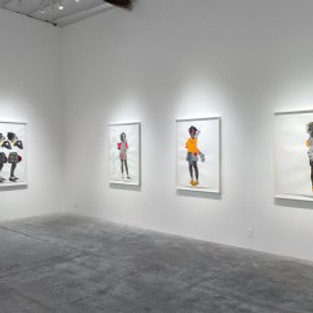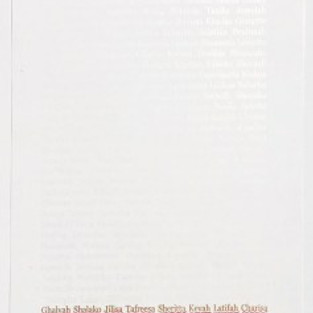
Deborah Roberts, Fragile but Fixable, Installation, at Luis De Jesus Los Angeles. Photo courtesy of the gallery.
Deborah Roberts: Fragile but Fixable
Luis de Jesus Gallery
Through June 16, 2018
By Shana Nys Dambrot
Mixed media collages by Deborah Roberts give physical expression to an essential psychosocial phase of human development — adolescence. Her works deftly interpret the time in everyone’s life when we really start to consciously figure out who we are becoming. Roberts takes a special focus on young women and in particular what is unique in such moments to the African-American experience. Yet at the same time, these pictures poignantly unpack the structure of what is also a fundamental human experience. Strong in broad strokes and rich in details, both lovely and unsettling, the works have a self-possession and presence that requires attention be paid.
Roberts constructs hybrid portraits, both fractured and holistic, harvesting meaning from her materials through a mix of found and made imagery. By using an assertively aggregating idiom like mixed media photo-based collage, she both shows and tells how the stories of her characters are the very narratives of acquiring the layers and textures of their personalities, in physical, spiritual, intellectual, sartorial, and literary traits. Her work employs a system for organizing elements of composition which mirrors the way the human brain learns and grows, by a sponge-like process of absorption, mimicry, experimentation, and eventually, decision-making. From many parts, one person.
Each young woman is shown to be a mix of aspects culled from several figures, often with extra limbs and adult-sized hands, as if suggesting the scale of what they still have to grow into in their lives, the promise and potential, the pathways of those who’ve gone before. It’s like a high-minded literary analogy to playing dress-up, tracing the acquisition of heroes. The empathy of works like these is universal, as the cusp-of-womanhood age-range is emblematic of adolescence as a time of transformation. But with Roberts’ compositions, the vernacular of the details in the iconography, as well as the race of the actual young women, speaks to a specific set of experiences to consider on its own terms.
The use of abstract patterns as textiles both deviates from and conforms to visual expectations, operating like Op Art but functioning pictorially as an essential part of the portraits, the garments. In fact, every element in Roberts’ pictures does at least two things. For example, the found photographs, painting, text, and drawing, including images of girls, radical and historical figures, and contemporary female role models like Michelle Obama and Gloria Steinem. These source images are both visual elements, often manipulated or obscured or transformed, and also they inhere in themselves content references that frame and move the story of what the work is doing.
The several pieces included that are lists of names rather than figurative portraits evoke 20th-century classics of word-art, but they are not just any names. Within the idea that list-making performs a visual function in the realm of painting and drawing, the thing with these particular names, is that those aren’t the names the nice white lady reads at the end of Romper Room. Susan, Jenny, Amanda…not so much Skarkesha, Shonique, or Latifah. That is but one way in which Roberts’ choices of source materials and augmented imagery interrogate the prevalence of whiteness, in face and name, as an accepted “universal” standard of beauty which leaves everyone else out. Ultimately Roberts’ visually stunning work succeeds by examining what is both unique about her girls, and also what their experiences can teach us all.
2685 S LA CIENEGA BOULEVARD LOS ANGELES, CA 90034
Tuesday through Saturday, 10:00 am – 6:00 pm, and by Appointment
#losangeles #california #losangelesartist #art #beverlyhills #losangelesart #contemporaryart #luisdejesus #southerncalifornia #LuisDeJesusGallery #abstract #collage #artgallery #gallery #culvercity #shananysdambrot #artandcake #artopening #assemblage #artexhibition #ArtandCakeLA #CulverCityArtsDistrict #fineart #artists #artist #soloshow #arts #CulverCityGallery #environment #artreview #artmagazine #DeborahRoberts #ArtandCulture #exhibition #CulverCityarts #drawing














































